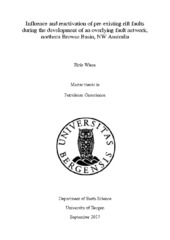| dc.description.abstract | Focusing on multiple events and interaction of different fault networks with the time being common in extensional settings such as passive margins and continental rifts. This study aims to better understand the interaction in normal fault networks and the influence of pre-existing structures on fault network growth and development. This is done by interpretation on 3-D reflection seismic volumes in the northern Caswell Sub-basin in the Browse Basin offshore the Australian NW Shelf. The focus is towards structural analysis of geometries, throw, spatial heterogeneity, characterise and analyse interactions and the influence of reactivation on underlying major rift faults. The normal fault network comprise Paleozoic-Mesozoic underlying ENE-trending rift faults setting up series of horsts and grabens. Above the rift-structures, is the ENE- to E-trending Neogene faults mostly spatially arranged as conjugated fault sets in en-echelon arrays. The spatial heterogeneity analysis and throw distribution show areas of distributed faulting with several faults and low throws, and areas of more localised faulting with fewer faults and greater throws. The high throws at Neogene faults match spatially with high throws at the rift faults, often at segments with geometric connection between the two fault populations. Interpretation of time-thickness maps show greatest amount of syn-rift activity in Permian and Triassic and lesser activity in Jurassic and Early Cretaceous, although basin sag is the main mechanism for thickening in Early Cretaceous. Extensional stress imposed in Miocene with similar orientation to pre-existing faults, cause nucleation of Neogene faults that dip-propagate simultaneously as pre-existing faults reactivate. Rotational splays created through the Cretaceous succession, connect the two fault populations by geometric linkage. These fault planes possess a throw minimum at the point of linkage close to the Turonian horizon, which might increase in throw with time as faults reach further equilibration stages. This study generally highlight the importance of pre-existing structures within a multiphase extension fault network, as these function as preferred nucleation sites and control strain distribution within the later developed Neogene fault population. Both through kinematic influence with soft-linkage and geometric control with hard-linkage developed by reactivation. This has implications for the regional geology and exploration, as connected faulting and reactivation might be more extensive than previously thought. This can ultimately cause effects for trap integrity and hydrocarbon migration. | en_US |
